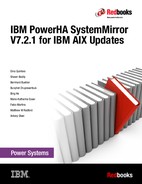

IBM PowerHA SystemMirror special features
This chapter covers specific features that are new to IBM PowerHA SystemMirror for IBM AIX for Version 7.2 and Version 7.2.1.
This chapter covers the following topic:
11.1 New option for starting PowerHA by using the clmgr command
Starting with of PowerHA V7.2, there is an additional management option to start the cluster. The new argument for the option manage is named delayed.
|
Note: This new option is backlevel ported to PowerHA V7.2 and 7.1.3. At the time of writing, you can obtain it by opening a Problem Management Report (PMR) and asking for an interim fix for defect 1008628.
|
Here is the syntax of the new option:
clmgr online cluster manage=delayed
11.1.1 PowerHA Resource Group dependency settings
Starting with PowerHA V7.1.0, the Start After and the Stop After dependencies are added. The Start After is used often. The Resource Group (RG) dependencies support up to three levels. Figure 11-1 shows a proposed setup that cannot be configured. If you encounter such a case, you must find another solution. In this example, RG1 is at level 1, RG2 is at level 2, RG3 and RG4 are at level 3, and RG5 and RG6 are at level 4.

Figure 11-1 Start After with more than three levels
A supported setup example is shown in Figure 11-2. It has the same number of RGs, but it is using three dependency levels. The challenges that you can get with such request are described in 11.1.2, “Use case for using manage=delayed” on page 405.

Figure 11-2 Start After with three levels
11.1.2 Use case for using manage=delayed
When you have multiple RGs with a similar dependency as the one that is shown in Figure 11-2, there is a challenge when the cluster is started. This section describes this behavior in more details.
Starting the entire cluster with the default settings
When starting the cluster in one go, for example, by using clmgr on cluster, then one of the two nodes always is the first one. In fact, it does not matter if you use clmgr or smitty. The sequence can be different, but that is the only difference.
The following section illustrates an example and does not describe the exact internal behavior. It is a description of what you can experience. Assume that Node A is the first one. Then, you get the startup situation that is shown illustrated in Figure 11-3:
1. (A) Cluster Manager on Node A is initialized.
2. (1) RG1 starts.
3. (2) The RG3 start fails due to the Start After dependency.
4. (3) The RG5 start fails due to the Start After dependency.
5. (B) The cluster manager on Node B is initialized
6. (4) RG2 starts.
7. (5) RG4 and RG6 start.
8. (6) RG3 and RG5 recover from the error status and start.
The startup takes longer than expected. Depending on your timeout settings, the start can have a significant time delay.

Figure 11-3 Start sequence (clmgr on cluster)
This behavior happens due to the fact that the first cluster manager does not see the partner at its initialization. This situation always happens even if there is a small time delay. Therefore, the second cluster manager must wait until all RGs are processed by the first cluster manager.
Starting the whole cluster with the first available node settings
A solution might be to change all the RGs to start on the first available node. The Start After settings are still the same as shown in Figure 11-2 on page 405. The assumption is that you still use the command clmgr on cluster command.
As shown in Figure 11-4, the start sequence is as defined in the Start After dependencies. But, now all RGs are running on Node A, which is not the outcome that you want.

Figure 11-4 Start sequence with the setting on first available node
Starting the whole cluster with the manual option
In the past, the only way to correct this situation was to use the manual option. For the example here, start with the original settings that are described in “Starting the entire cluster with the default settings” on page 405. Run the clmgr on cluster manage=manual. This command starts both cluster managers but not the RG.
Now, the cluster managers are running in a stable state, as shown in Figure 11-5. You can start all your RGs by using the clmgr command.

Figure 11-5 RG start sequence when all the cluster managers are running
..................Content has been hidden....................
You can't read the all page of ebook, please click here login for view all page.
